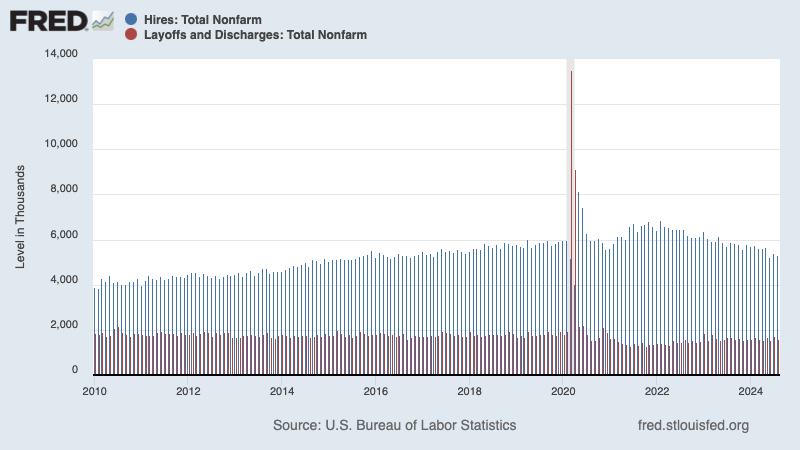
On Friday, we learned the U.S. economy created a healthy 254,000 net new jobs in September. While the number confirms that the labor market isn’t falling apart, the pace of net job creation has cooled from levels seen earlier in this economic cycle.
One labor market indicator that’s been drawing more attention lately is the hiring rate. In addition to measuring those hired into newly created jobs, this metric also captures those hired into existing jobs vacated by quitters, fired workers, and others. It’s been trending lower, and it could be a sign of problems to come.
According to the Job Openings and Labor Turnover Survey (JOLTS) report, employers hired 5.32 million workers in August. While hires far exceed the 1.61 million people laid off during the period, the hiring rate — the number of hires as a percentage of the employed workforce — has fallen to 3.1%, matching the lowest level of the current economic cycle.
The number of hires continues to outpace the number of layoffs. FRED
As we’ve been discussing for a while, the layoff rate has remained depressed, trending at around 1%, which is below prepandemic levels. That’s a good thing. (More on layoffs here, here, here, and here.)
But with labor market tailwinds fading, we should be at least a little wary about resting on the economy’s low layoff laurels.
“The hiring rate turns BEFORE layoffs,” Renaissance Macro’s Neil Dutta explained in a research note on Tuesday.
When you think about how well-managed companies operate, this makes sense.
Managers Know That A Hiring Freeze Isn’t Great News
When the economic tides begin to go out, companies usually don’t go from hiring people one month to immediately sending workers to the unemployment office in the next month.
Unless you’re facing a major business or economic calamity, you probably don’t want to take a hatchet to the headcount. Because what if business activity quickly turns around and you need those workers?
For starters, companies can reduce or freeze hiring, which means not filling new job openings or backfilling roles vacated by former employees. It’s a relatively easy way to keep expenses contained.
If challenges persist, then layoffs could be the next option.
The layoff rate remains very low. Will it last? FRED
It’s worth mentioning that layoff activity does not need to increase for the unemployment rate to rise. Think about it. Even when the economy is booming, many people are getting laid off every month — but many will quickly go back to work if hiring activity is strong. If the same number of people get laid off into an economy with weakening hiring activity, then more jobseekers will not be able to get back to work, and unemployment rises.
Stay Vigilant
The JOLTS survey — which provides data on job openings, hiring activity, layoffs, and quits — can be helpful in predicting what’s to come for the major headline economic metrics like net job creation, the unemployment rate, and inflation.
For example, when the level of job openings posted by employers is high and rising, then you can expect payroll employment to rise and the unemployment rate to fall or stay low. An elevated quits rate could be a reflection of worker confidence in a labor market with increasingly competitive wages, which is a sign that inflation is on the rise.
Today, with the labor market cooling but the layoff rate still depressed, the JOLTS metric to watch right now may be the falling hiring rate.
The question now is whether the economy, now aided by the Federal Reserve, will develop in a way that helps stabilize or improve the hiring rate. Friday’s news that the U.S. continues to create jobs at a healthy pace is encouraging.
And to be crystal clear, most metrics point to a strong economy that continues to grow at a healthy clip. In fact, the hiring rate today is higher than where it was during much of the 2009-2020 economic expansion. Our discussion today is not about sounding alarms. However, we should always be mindful of the fact that economic downturns do happen. And those downturns often come with early warning signs.
A version of this post was originally published on Tker.co.
© 2024 Benzinga.com. Benzinga does not provide investment advice. All rights reserved.




